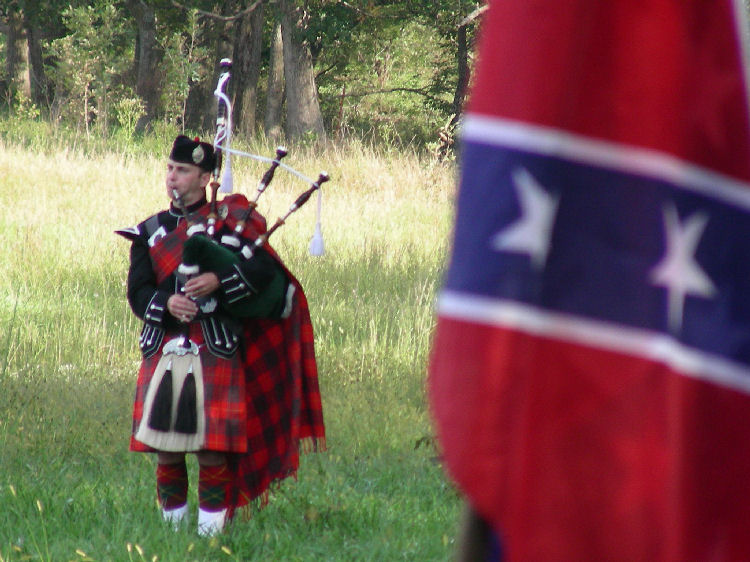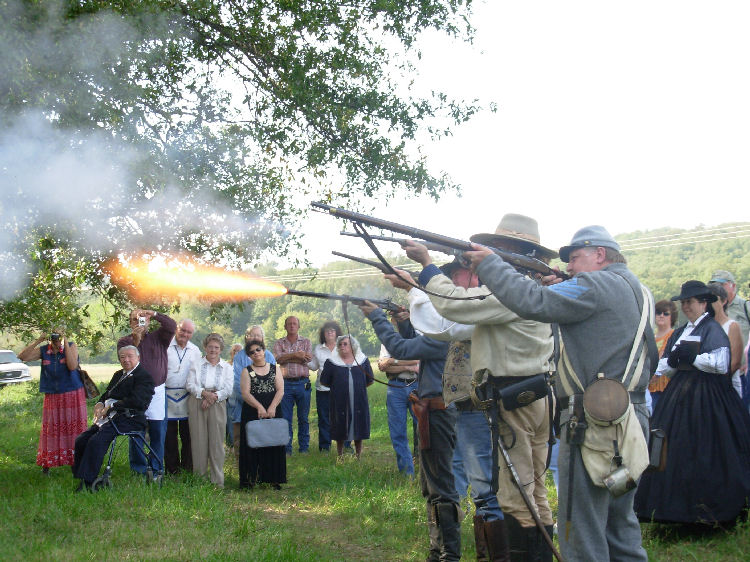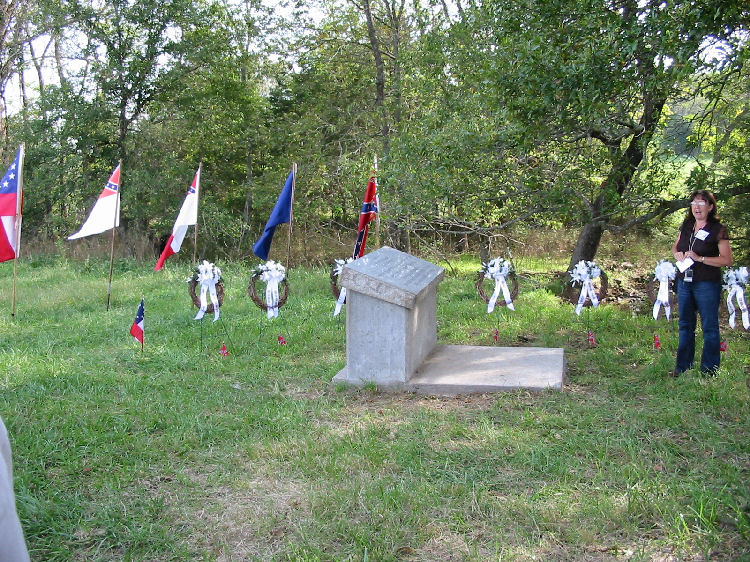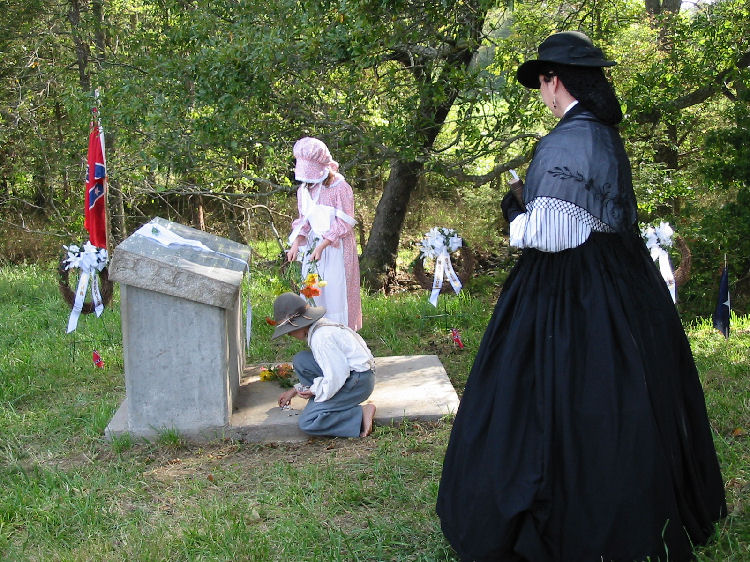
Bagpipes

Gun Volley

Joy Russell at Monument

Luella Wood & Kids in Period Costumes
Huntsville Massacre Monument Dedication
From The Morning News,
Monday October 16, 2006
Honoring Fallen Civilians
Massacre Monument Dedicated
By
Abby Burnett, Special to The
Morning News
In
the icy predawn of January 10, 1863, nine civilian men were lined up and shot by
a Union firing squad at the troops’ encampment near Huntsville in Madison
County. It was
a killing apparently without motive; those responsible went unpunished, and
those who knew what had happened did not talk about the
events.
Now, 143 years later, the site of the Huntsville
Massacre has been marked with a granite monument, commemorating a piece of
history retrieved – with difficulty and much research – from oblivion. The tablet, erected on private property a
year ago, was dedicated September 30, 2006, at an event marked by Masonic rites,
a gun volley by Civil War re-enactors, prayers, poetry and a bagpiper playing
“Amazing Grace”.
Both the creation of the marker and the dedication service
were the work of the Madison County Genealogical and Historical Society, aided
by Huntsville Masonic Lodge 364.
Historian Kevin Hatfield was on hand to talk about the
events that led up to the massacre.
This story – which Hatfield piece together from Civil War diaries and
letters, census records, and personal histories – had all the elements of a
mystery novel, one in which vengeance provided a motive. (The Winter 2006 issue of “The Musings”, Madison County Genealogical and Historical Society’s
quarterly publication, will contain an expanded account by Hatfield
.)
“This was an event so tragic that people would not talk
about it for 100 years”, Hatfield said.
“It was an event that would change the face
of Huntsville and the county, and have a far-reaching effect on us
today.”
Setting the
Scene
In
1861, before the onset of the Civil War, Arkansas held a vote on whether to
secede from the Union. Madison
County sent Isaac Murphy, overseer of Huntsville’s two Masonic colleges, as its
delegate to vote in favor of remaining in the Union, and this vote passed. However, with the firing on Fort Sumter,
S. C., and the start of the Civil War, delegates were recalled to Little Rock
and asked to vote again. This time the majority favored secession –
with Murphy’s being the solitary dissenting vote.
For
a time, Huntsville citizens were not unhappy with Murphy’s action, but
gradually, after he left to fight on the Union side, opinion changed. By the fall of 1863, people had begun
harassing Murphy’s daughters.
Frightened, they fled to where their father was camped at Pea Ridge. In November, with the Battle of Prairie Grove
soon to start, he sent them home, protected by an escort of 25 Union
soldiers.
The
girls made it back to Huntsville unharmed, but the soldiers there not so
lucky. As they returned to
camp, they were surprised by guerilla fighters just west of Huntsville; 18
soldiers were killed.
After the
Battle of Prairie Grove, half of the Union troops, en route to join Gen. Grant’s
army,
passed through
Huntsville and camped a mile north of town.
“It was time for payback”, Hatfield
said, giving proof that Union officers knew about the attack on the Murphy
daughters’ escort.
Although many families had left Huntsville, men in the
area were told to return to take an oath of allegiance to the Union. Some of those who returned were put under arrest.
Hatfield believes Isaac Murphy, E. D. Ham, and Col.
James Johnson chose those who were arrested on suspicion of having taken part in
the attack on the escort. Of the
men arrested, four were Masons.
Their names were Chesley Boatright, William Martin Berry, Hugh Samuel
Berry, John William Moody, Askin Hughes, John Hughes, Watson Stevens and Robert
Coleman Young. Bill Parks, who
survived the massacre, is believed to be the ninth man.
At
4 a.m. on January 10, 1863, these nine were taken from the guardhouse to the
edge of little creek bordering the field where the troops camped. There they were shot. Parks, badly injured, survived and crawled to a nearby house, where he
was nursed until well enough to escape the area; one man lived a day – long
enough to tell what had happened.
“Who did this?” asked a
woman in a letter to a friend who lived on a nearby farm, “Men of the 8th
Missouri Regiment,” was the reply.
“But Johnson, Ham and
Murphy had it done.”
Keeping
Secrets
It’s not that the massacre was never commemorated. After the killings a wooden fence – now long vanished – was placed around
the spot, and the site’s last owner was able to lead local historians to where
he remembered it having been.
“For the next 80 years, no one
talked,” Hatfield said, “but every year, school kids decorated the site with
wildflowers and mussel shells, and until recently, some of the shells were still
there.
Hatfield remembers the local interest – and
conversations – that ensued in 1974 after historian John I. Smith published a
series of articles about the massacre in the Northwest Arkansas Times. Smith ran across the story while researching a biography of Isaac Murphy
– who later became the eighth governor of Arkansas, retired to Huntsville, and
is buried in the same cemetery as at least two of the massacre victims.
Not
only did Murphy go on to have an illustrious career, no one responsible for the
massacre was ever punished. Court
martial proceedings against the officer in charge were halted, for lack of
testimony. Johnson was later
elected to Congress and served as Arkansas’ lieutenant governor and secretary of
state, while lawyer E. D. Ham went on to become a state senator, district
attorney and circuit judge.
(Hatfield
speculates Ham’s motive might have stemmed from being black-balled by the town’s
Odeon Masonic Lodge.)
Hatfield was serious when he said the massacre changed
the course of the county’s history.
Huntsville’s two colleges – founded by the
Masons in 1854 – closed during the war, as did the Odeon Lodge after three
members were expelled, the lodge “torn apart” and its charter
revoked.
Furthermore, Hatfield said, it was Johnson who
eventually picked the site of the University of Arkansas in Fayetteville. Had
the two Masonic colleges remained intact, Hatfield believes, Huntsville would
have been an obvious choice for the location of the new university.
Honoring The Dead
At the
dedication of the monument, nine grapevine wreaths, each draped in a ribbon
bearing the name of one of the victims, ringed the marker. Members of Huntsville
Masonic Lodge 364, Free and Accepted Masons, provided a ceremony to honor these
men.
"We knew them not, but they were our brothers," intoned Doug Dobbyn,
explaining the significance of the lambskin apron and sprig of evergreen
ceremoniously placed atop the marker.
"A Master Mason must request a
Masonic funeral," Dobbyn explained after the ceremony, noting the executed
Masons could not have made their wishes known. "This is not a full-blown funeral
service, but we wanted to honor them."
They also were saluted with three
rifle volleys, carried out by members of the First Arkansas Light Artillery.
This group of Civil War re-enactors includes members of the Sons of Confederate
Veterans, and both groups attend events honoring Confederate
veterans.
"We don't always realize that we're standing where history
happened," said historian Joy Russell, president of the county's Genealogical
and Historical Society. "Four to six thousand troops camped in these fields,
here. We're standing where history occurred for Madison
County."
Re-enactor Luella Wood, attired in a hoop-skirted mourning
outfit, read aloud a poem by Civil War-era poet Henry Timrod. Titled "Ode at
Magnolia Cemetery," the poem concludes with this verse:
|
The
Monument
|  Bagpipes |
Gun Salute
|
 Gun Volley |  Joy Russell at Monument |  Luella Wood & Kids in Period Costumes |
Copyright
© 2007 by Peggy J. Rogers and the submitters. All rights
reserved.
This
site may be freely linked to but not copied in any fashion without written
consent.